1. An overview of Lao P.D.R.
Lao P.D.R. (Laos) is a land-locked country, surrounded by China, Myanmar, Vietnam, Thailand and Cambodia, located centrally on the Indochina peninsula of South East Asia. The capital city of Laos is Vientiane, and the Mekong river runs along the greater part of the country's western border with Thailand. The climate of Laos is classified as tropical monsoon, with a rainy season from May to November, and a dry season from December to April (Central Intelligence Agency, 2016).
Laos has been striving to get rid of its least developed country status by 2020 (IMF, 2004), and actually has made significant economic growth at an annual rate of about 8% over the last 10 years (Central Intelligence Agency, 2016). This can be regarded as being a result of the country gaining its independence in 1975 as a socialist state, after 600 years of Imperial Rule. The open market policy then started in 1988, and its membership of ASEAN was confirmed in 1997. However, the latest data (2009-2012) shows that about 34% of the country's population still subsist below the international poverty line of 1.25 USD per day (UNICEF, 2015). In addition, the country has not sufficiently developed its agricultural and social infrastructure. This situation has been attributed to the following reasons (Mekong, 2003; UNESCO, 2008; Lao Statistic Bureau 2014; Statistic Bureau, Ministry of Internal Affairs and Communications, 2016a&b; Ministry of Foreign Affairs, 2016). First, the country is sparsely populated (about 27 people per square kilometre), with about 240,000 square kilometres of land (almost the same as the main island of Japan), and a population of about 6.49 million (about one third that of Japan's population). Second, the country has a challenging geographic situation, i.e. it is land-locked and mountainous with 67.9% of the land being forested. Third, the country has repeatedly endured foreign occupation: the Lang Xang Kingdom, established in the 14th century, was conquered by Siam (currently Thailand) in the late 18th century, and was then absorbed into French Indochina in 1893; after being occupied by the Japanese military during World War 2, the country was conquered by France again, and then embroiled in the Vietnam War in the 1960s, which left many unexploded bombs which have been a serious and persistent source of danger for the Lao people. The country relies heavily on its poor agricultural base which is focused on rice production in the limited lowland areas and represents about 25% of the national GDP and 73% of its employment (Central Intelligence Agency, 2016). In addition, the country's export trade depends heavily on capital-intensive natural resource exports, such as hydro-electric power generation from use of the Mekong river, mining, logging and construction (Central Intelligence Agency, 2016).
Large disparities between the ethno-linguistic groups within Laos have also proved a major problem. According to official data, there are 49 ethnic groups which have their own different customs and languages, and can be categorised into 4 broader groups: Lao-Tai (8 ethno-linguistic groups, 65% of the country's population); Austro-Asiatic (32 ethno-linguistic groups, 22% of the country's population); Hmong-Yu Mien (2 ethno-linguistic groups, 9% of the country's population); Shino-Tibetan (7 ethno-linguistic groups, 3% of the country's population) (UNESCO, 2008). Among these 4 larger groups, a majority of the Lao-Tai group speak the national language of Lao, have strong political, economic and social power, and live in the lowlands which offer geographical advantages (World Bank, 2006).
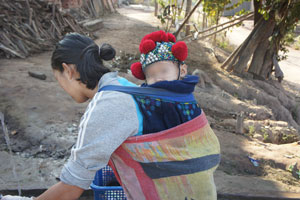
A mother and a child of the Yao tribe (Hmong-Yu Mien) in a mountainous area in the Luang Namtha Province in the north of Laos
Looking at the situation of children in Laos, it is found that the child population rate is quite high: in 2013, young people under the age of 18 made up about 42% of the population, and those under the age of 5 made up about 13% of the population (UNICEF, 2015). However, it is evident that the quality of life for children in the country is not particularly high; for 2013 the infant mortality rate was 54/1000, the under-5 mortality rate was 71/1000 and the under-5 stunting rate was 43.8% for the period from 2009 to 2013. In addition, the literacy rate of people over the age of 15 was 72.7% in 2009-2010 and life expectancy was 68.3 years in 2013 (UNICEF, 2015).
2. The system, policies, current situation and challenges of education in Laos
The constitution of Laos (proclaimed in 1991 then revised in 2003) states that, "The purpose of educational, cultural and scientific activities is to increase the level of knowledge, patriotism, enhance love of democracy, strengthen the solidarity of various ethnic groups, and the spirit of independency (Act 19)". On the basis of this, the Education Law (proclaimed in 2000 later revised in 2007) declares that, "All the citizens of Laos have the right to receive an education regardless of their ethnicities, families, religions, gender or social status (Act 3)", and ensures the responsibility of the government for the education of the citizens, with a special focus on rural ethnic groups, women, marginalised people and talented people (Act 5). In addition, primary education is to be provided as compulsory and for free (Primary Compulsory Education Law, 1996).
The formal education system in Laos consists of General Education [Early Childhood Education: nursery (ages 0-2), kindergarten (ages 3-5), and preschool (newly established only for age 5s), Primary Education (ages 6-10 for 5 years), Lower Secondary Education (ages 11-14 for 4 years), Upper Secondary Education (ages 15-17 for 3 years)], Technical and Vocational Education and Training (TVET) and Higher Education (UNESCO, 2008). On the other hand, non-formal education is provided mainly for adults and children who have never attended school.
The Ministry of Education and Sports (MoES) has the responsibility as the secretariat for all levels of education, including both formal and non-formal, as well as public and private (UNESCO, 2008). However, since decentralisation has been promoted, the Provincial Education Service (PES) and District Education Bureau (DEB) *1 have acquired increasing responsibility for education. The DEB takes charge of Early Childhood and Primary Education, while the PES has responsibility for Lower and Upper Secondary Education, Higher Education and TVET.
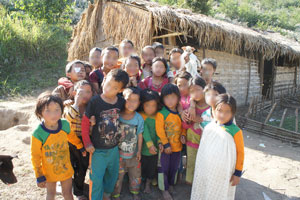
Children of the Akha tribe (Shino-Tibetan) in front of their primary school in a mountainous area in the Luang Namtha Province in the north of Laos
In order to be rid of its least developed country status by 2020, and achieve the Millennium Development Goals (MDGs) by 2015, the Lao government has been working on education as the key factor (MoES, 2005). In the "Education for All: National Plan of Action 2003-2015 (EFA-NPA) ", which was formulated to realise the above mentioned goals and the UNESCO-led "Education for All (EFA)", the following three objectives were set to be achieved at all levels of education, regardless of a child's situation, such as their family's financial status, ethnicity, dwelling place or gender: 1) equal access to and participation in education; 2) improvement of quality and relevance of education; 3) strengthening the management of education. This plan prioritises early childhood, primary, lower secondary, non-formal, and skills training. It aims to realise the above mentioned three objectives by implementing basic education for all, focusing on disadvantaged groups, increasing the participation of communities in basic and literacy education, and improving the quality and relevance of basic education through educational opportunities.
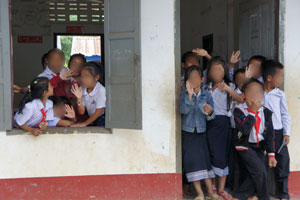
Children attending a primary school located
in the centre of the Sekong Province in the south of Laos
Since 2015, it can be claimed that Laos has become able to improve its fundamental structure of education, such as access to education, gender equality, (re)construction of schools, improvement of facilities, increased school subsidies and betterment of teachers' working conditions (EFA 2015 Review Group and Secretariat Group, Lao PDR, 2014). However, based on these factors, further improvement in education is expected, such as improvement in students' academic achievements and mobility, quality of teachers and the capacity building of those supporting education in communities.
3. The system, policies, current situation and issues of ECCE in Laos
The importance of Early Childhood Care and Education [nursery (ages 0-2), kindergarten (ages 3-5), and preschool (age 5 only)] has recently become increasingly recognised by developing countries and development agencies. This is considered to be partly a result of accumulated research on the effects of ECCE on individuals and society (See Reynolds et al., 2002; Barnett & Ackerman, 2006; Belfield et al., 2006), and the influence of international commitments, such as the Convention on the Rights of the Child, EFA, MDGs and Sustainable Development Goals (SDGs). ECCE is considered to be capable of supporting children's holistic development and readiness for primary education, enhancing their academic achievement in the long term, helping them to be healthy and productive citizens in the future. All of this should have the result of promoting the social and economic development of the country (UNESCO, 2006; UNICEF, 2013; Naudeau et al., 2015; World Bank, 2015).
Given this situation, the Lao government has also increased its awareness of the importance of ECCE. The Education Law (2008) states that, "Early Childhood Education should ensure that children develop holistically, know the foundation of talking, writing, reading, listening, looking at, and drawing, love their parents, teachers, those surrounding them, county, nature and clearness, have talents, love to learn, and prepare themselves for primary education (Article 15)". In addition, in the above mentioned EFA-NPA, ECCE is regarded as important because it is considered that ECCE can support children's readiness for primary education and stimulate the country's future socio-economic growth. Therefore, the improvement of access and participation, quality and relevance, and management of ECCE is being targeted. In doing so, children aged 5, especially those from ethnic minorities and poor families, along with girls are prioritised, and the establishment of preschools for 5-year olds is being promoted. Community based ECCE Centres are also in line to be disseminated under this system.
As a result of these policies, the access to ECCE in Laos has been significantly improved (EFA 2015 Review Group and Secretariat Group, Lao PDR. 2014). The number of ECCE classrooms and teachers has markedly increased (Figure 1), and also the gross enrolment rate (GER) in ECCE programmes at age 5 was almost 4 times higher in 2014 (60.8%) than it was in 2007 (16.1%) (Figure2), which already exceeded the target in the EFA-NPA in 2015 (50.6%). In addition, the percentage of new entrants to grade 1 of primary with preschool experience more than quadrupled, from 10.8% in 2007 to 45.4% in 2014, making it highly likely that the EFA-NPA target for 2015 (50.2%) will be reached. It is also clear that there is almost no difference between boys and girls in terms of the GER and the percentage of children who enter primary grade 1 with preschool experience.
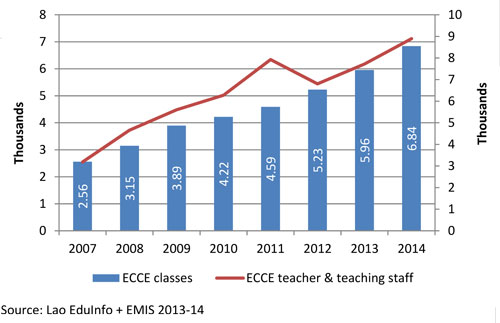
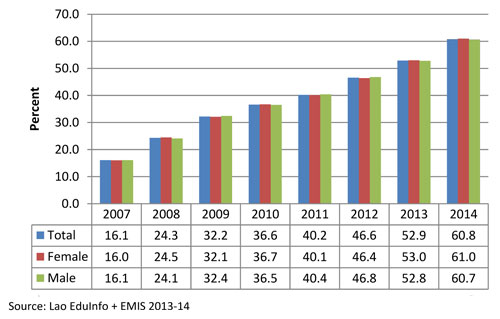
However, it is still necessary for Laos to make an effort to improve the quality and relevance of its ECCE programmes, and establish equality in the programmes between children from families of various ethnicities and financial situations. To achieve this, it is considered necessary to disseminate community based ECCE centres, increase the quality of teachers, and realise the continuous employment of these teachers.
4. An example of ECCE institutions in Laos (a public nursery and kindergarten attached to a Teacher Training College (TTC))
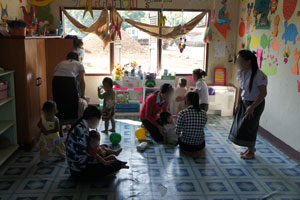 |
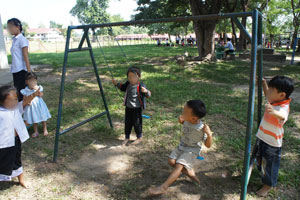 |
|
in the attached nursery |
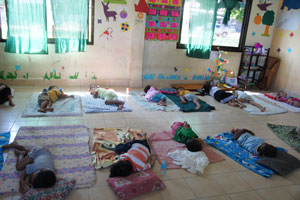
Senior children of the kindergarten taking an afternoon nap
In this public nursery and kindergarten, which has 5 classrooms for those at ages 0-1, 2, 3, 4 and 5 respectively, about 100 children in total attend the ECCE programmes delivered by 10 teachers (2 teachers per classroom). Most of the children come from the local neighbourhood due to the needs for care during their parents' working hours, and for the purpose of acquiring basic literacy and numeracy. The following chart indicates the general flow of the day in the kindergarten.
| Hours | Activities |
|---|---|
| 7:30-10:00 | Coming to the kindergarten & free play |
| 10:00-11:00 | Teacher-led activities |
| 11:30-12:15 | Lunch |
| 12:30-14:30 | Afternoon nap |
| 14:30-15:30 | Taking a shower, changing clothes & having a snack |
| 15:30-17:00 | Free play & going back home |
This nursery and kindergarten has a classroom for each age group, a hall, a teachers' room, some restrooms with bathing facilities, and a playground with some simple play equipment, trees and a small vegetable field. The classrooms have, as is usual with Lao houses, tiled floors to make people feel cool, and fans on the ceilings suitable for hot weather. There are toys on the shelves, such as paper cards with Lao characters and numbers hand-made by the TTC students, and picture books written in Lao which are provided as aid from development agencies. The teacher-led activities in the morning include those with the children making a circle together in the classroom, and learning Lao characters and numbers, in which teachers use songs, games and teaching materials such as picture cards, following the themes of the day in the national curriculum, such as "family" or the "Lao New Year". The teacher-led activities are designed for the children to learn, while free play is designated as a time for them to take a rest.
The most surprising aspect for the author at the nursery and kindergarten is that the children there are quite vigorous in their mental attitude. They often sustain minor injuries during their free play as they use the play equipment and climb the trees in the playground whilst barefoot. However, they normally change their mood quickly even if they succumb to tears due to their injuries. It seems they want to play more and more, rather than being overly concerned about their injuries. This makes the author reconsider the importance of supporting children's development in mental vigor in ECCE, although it is still hugely important to ensure their safety.
5. Discussion
It is claimed that the improvement in the quality of ECCE teachers is of prime importance in order to promote children's holistic development, providing programmes responsive to every child with their different developmental levels, interests, cultures and languages in various situations, while making the most of limited funds, materials and facilities (OECD, 2012). To improve the quality of ECCE teachers, it is considered important to offer them sufficient training, improve their working conditions, such as the teacher-to-child ratio, salaries and other benefits, workload, turnover rate, physical work environment, abilities and supportiveness of managers of the ECCE institutes (OECD, 2012). The Lao government has focused on the improvement of the quality of teachers to realise quality education over the country as a whole. In doing so, improvement of the quality of ECCE teachers has also been targeted, including further research on the training and working conditions of ECCE teachers with the support of UNESCO Bangkok. As a result of these efforts, the number of trained ECCE teachers has shown an increase, from 3,179 in 2009-10 to 5,472 in 2013-14, which represents 62% of the total number of ECCE teachers in Laos (EFA 2015 Review Group and Secretariat Group, Lao PDR. 2014). There is a sincere hope that the support system for ECCE teachers will be further improved, and that the holistic development of children will be increasingly promoted.
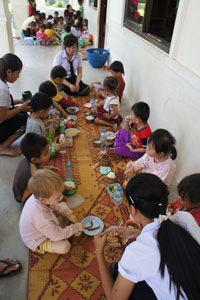
Senior children of the kindergarten having lunch
- *1 Laos consists of 17 provinces and 1 capital city municipality, both of which are subdivided into districts.
-
Bibliography
- Statistics Bureau, Ministry of Internal Affairs and Communications. 2016a. "Jinkousuikei no kekka no gaiyou: Kakutsuki tsuitachi genzai jinkou: Heisei 28 nen 4 gatsu hou (Heisei 27 nen 11 gatsu kakuteichi, Heisei 28 nen 4 gatsu gaisanchi) [Outline of the population estimates: Population as of the 1st day of each month: Report of April, 2016 (Confirmed figure as of November, 2015; Estimate figure as of April, 2016)]" Available: http://www.stat.go.jp/data/jinsui/2.htm#monthly [Accessed 13/05/2016]
- Statistics Bureau, Ministry of Internal Affairs and Communications. 2016b. "Dai 1 shou kokudo, kishou: kokudojyoukyou [Chapter 1: National land, climate: the situation of the national land" Available: http://www.stat.go.jp/data/nihon/01.htm [Accessed 13/05/2016]
- Latanavon, H. 2003. Introduction. In: Laos bunka kenkyujyo [Research Institute of Lao Culture] (eds.) "Laos gaisetsu [The outline of Laos]" Tokyo: Mekong.
- Ministry of Education and Sports of Lao P.D.R. 2005. Education for All: National Plan of Action 2003-2015. UNESCO Bangkok, Asia and Pacific Regional Bureau for Education.
- Barnett, W. S. & Ackerman, D. J. 2006. Costs, Benefits, and Long-Term Effects of Early Care and Education Programs: Recommendations and Cautions for Community Developers. Community Development, 37, 86-100.
- Belfield, C. R., Nores, M., Barnett, S. & Schweinhart, L. 2006. The High/Scope Perry Preschool Program: Cost-Benefit Analysis Using Data from the Age-40 Followup. The Journal of Human Resources, 41, 162-190.
- Central Intelligence Agency. 2016. The World Factbook: East & Southeast Asia: Laos. [Online] Available: https://www.cia.gov/library/publications/the-world-factbook/geos/la.html [Accessed 13 May 2016]
- EFA 2015 Review Group and Secretariat Group, Lao PDR. 2014. National EFA 2015 Review Report: Country Report of Lao PDR.
- IMF. 2004. Lao People's Democratic Republic: Poverty Reduction Strategy Paper: National Growth and Povety Eradication Strategy. Washington, D.C.
- Laos Statistics Bureau. 2014. Citizens Laos 2015. [Online] Available: http://lsb.gov.la/Schedule.php [Accessed 13 May 2016]
- Naudeau, S., Kataoka, N., Valerio, A., Neuman, M. J. & Elder, L. K. 2015. Investing in Young Children: an early childhood development guide for policy dialogue and project preparation. Washington, D. C, World Bank.
- OECD, 2012. Starting Strong III: a quality toolbox for early childhood education and care, Paris.
- Reynolds, A. J., Temple, J. A., Robertson, D. L. & Mann, E. A. 2002. Age 21 Cost-Benefit Analysis of the Title I Chicago Child-Parent Centers. Educational Evaluation and Policy Analysis, 24, 267-303.
- UNESCO 2006. EFA Global Monitoring Report 2007: Strong Foundations Early Childhood Care and Education. Paris.
- UNESCO Bangkok, Asia and Pacific Regional Bureau for Education. 2008. UNESCO National Education Support Strategy Lao People's Democratic Republic 2008-2013, Bangkok.
- UNICEF. 2013. Why Early Childhood Development? [Online]. Available: http://www.unicef.org/earlychildhood/index_40748.html [Accessed 16 May 2016].
- UNICEF. 2015. The State of the World's Children Report 2015 Statistical Tables. [Online] Available: http://www.unicef.org/infobycountry/laopdr_statistics.html [Accessed 13 May 2016]
- World Bank. 2006. Lao PDR Poverty Assessment Report: from valleys to hilltops 15years of poverty reduction Vollume2: Main report. Washington, D. C.
- World Bank. 2015. Impact of interventions during early childhood on later outcomes: a systematic review.














